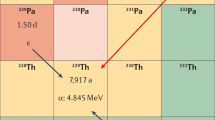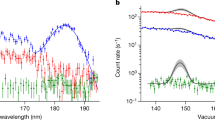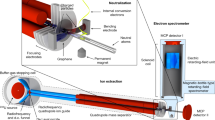Abstract
The metastable first excited state of thorium-229, 229mTh, is just a few electronvolts above the nuclear ground state1,2,3,4 and is accessible by vacuum ultraviolet lasers. The ability to manipulate the 229Th nuclear states with the precision of atomic laser spectroscopy5 opens up several prospects6, from studies of fundamental interactions in physics7,8 to applications such as a compact and robust nuclear clock5,9,10. However, direct optical excitation of the isomer and its radiative decay to the ground state have not yet been observed, and several key nuclear structure parameters—such as the exact energies and half-lives of the low-lying nuclear levels of 229Th—remain unknown11. Here we present active optical pumping into 229mTh, achieved using narrow-band 29-kiloelectronvolt synchrotron radiation to resonantly excite the second excited state of 229Th, which then decays predominantly into the isomer. We determine the resonance energy with an accuracy of 0.07 electronvolts, measure a half-life of 82.2 picoseconds and an excitation linewidth of 1.70 nanoelectronvolts, and extract the branching ratio of the second excited state into the ground and isomeric state. These measurements allow us to constrain the 229mTh isomer energy by combining them with γ-spectroscopy data collected over the past 40 years.
This is a preview of subscription content, access via your institution
Access options
Access Nature and 54 other Nature Portfolio journals
Get Nature+, our best-value online-access subscription
$29.99 / 30 days
cancel any time
Subscribe to this journal
Receive 51 print issues and online access
$199.00 per year
only $3.90 per issue
Buy this article
- Purchase on Springer Link
- Instant access to full article PDF
Prices may be subject to local taxes which are calculated during checkout





Similar content being viewed by others
References
Beck, B. R. et al. Energy splitting of the ground-state doublet in the nucleus 229Th. Phys. Rev. Lett. 98, 142501 (2007).
Beck, B. R. et al. Improved Value for the Energy Splitting of the Ground-State Doublet in the Nucleus 229m Th. Report No. LLNL-PROC-415170 (Lawrence Livermore National Laboratory, 2009).
Kroger, L. A. & Reich, C. W. Features of the low-energy level scheme of 229Th as observed in the α-decay of 233U. Nucl. Phys. A 259, 29–60 (1976).
Helmer, R. G. & Reich, C. W. An excited state of 229Th at 3.5 eV. Phys. Rev. C 49, 1845–1858 (1994).
Peik, E. & Tamm, C. Nuclear laser spectroscopy of the 3.5 eV transition in Th-229. Europhys. Lett. 61, 181–186 (2003).
Matinyan, S. Lasers as a bridge between atomic and nuclear physics. Phys. Rep. 298, 199–249 (1998).
Flambaum, V. V. Enhanced effect of temporal variation of the fine structure constant and the strong interaction in 229Th. Phys. Rev. Lett. 97, 092502 (2006).
Flambaum, V. V. Enhancing the effect of Lorentz invariance and Einstein’s equivalence principle violation in nuclei and atoms. Phys. Rev. Lett. 117, 072501 (2016).
Campbell, C. J. et al. Single-ion nuclear clock for metrology at the 19th decimal place. Phys. Rev. Lett. 108, 120802 (2012).
Kazakov, G. A. et al. Performance of a 229Thorium solid-state nuclear clock. New J. Phys. 14, 083019 (2012).
Peik, E. & Okhapkin, M. Nuclear clocks based on resonant excitation of γ-transitions. C. R. Phys. 16, 516–523 (2015).
von der Wense, L. et al. Direct detection of the 229Th nuclear clock transition. Nature 533, 47–51 (2016).
Takano, T. et al. Geopotential measurements with synchronously linked optical lattice clocks. Nat. Photon. 10, 662–666 (2016).
Hayes, A. C. & Friar, J. L. Sensitivity of nuclear transition frequencies to temporal variation of the fine structure constant or the strong interaction. Phys. Lett. B 650, 229 (2007).
Berengut, J. C. et al. Proposed experimental method to determine α sensitivity of splitting between ground and 7.6 eV isomeric states in 229Th. Phys. Rev. Lett. 102, 210801 (2009).
Thielking, J. et al. Laser spectroscopic characterization of the nuclear-clock isomer 229mTh. Nature 556, 321–325 (2018).
Seiferle, B. et al. Energy of the 229Th nuclear clock transition. Nature https://doi.org/10.1038/s41586-019-1533-4 (2019).
Jeet, J. et al. Results of a direct search using synchrotron radiation for the low-energy 229Th nuclear isomeric transition. Phys. Rev. Lett. 114, 253001 (2015).
Yamaguchi, A. et al. Experimental search for the low-energy nuclear transition in 229Th with undulator radiation. New J. Phys. 17, 053053 (2015).
Stellmer, S. et al. Attempt to optically excite the nuclear isomer in 229Th. Phys. Rev. A 97, 062506 (2018).
Browne, E. & Tuli, J. K. Nuclear data sheets for A = 229. Nucl. Data Sheets 11, 2657–2724 (2008).
Seto, M. Condensed matter physics using nuclear resonant scattering. J. Phys. Soc. Jpn. 82, 021016 (2013).
Yabashi, M. et al. Design of a beamline for the SPring-8 long undulator source 1. Nucl. Instrum. Methods Phys. Res. A 467–468, 678–681 (2001).
Krywka, C. et al. Polymer compound refractive lenses for hard X-ray nanofocusing. AIP Conf. Proc. 1764, 020001 (2016).
Masuda, T. et al. Energy response of X-rays under high flux conditions using a thin APD for the energy range of 6–33 keV. Nucl. Instrum. Methods Phys. Res. A 913, 72–77 (2019).
Masuda, T. et al. Fast X-ray detector system with simultaneous measurement of timing and energy for a single photon. Rev. Sci. Instrum. 88, 063105 (2017).
Bond, W. L. Precision lattice constant determination. Acta Crystallogr. 13, 814–818 (1960).
Raboud, P.-A., Dousse, J.-Cl., Hoszowska, J. & Savoy, I. L 1 to N 5 atomic level widths of thorium and uranium as inferred from measurements of L and M X-ray spectra. Phys. Rev. A 61, 012507 (1999).
Firestone, R. B. et al. Table of Isotopes 8th edn (John Wiley & Sons, 1996).
Yoshimi, A. et al. Nuclear resonant scattering experiment with fast time response: photonuclear excitation of 201Hg. Phys. Rev. C 97, 024607 (2018).
Berger, M. J. et al. NIST Photon Cross Sections Database XCOM: Photon Cross Section Database (version 1.5) http://physics.nist.gov/xcom (National Institute of Standards and Technology, 2010).
Barci, V. et al. Nuclear structure of 229Th from γ-ray spectroscopy study of 233U α-particle decay. Phys. Rev. C 68, 034329 (2003).
Tkalya, E. V. et al. Radiative lifetime and energy of the low-energy isomeric level in 229Th. Phys. Rev. C 92, 054324 (2015).
Kazakov, G. A. et al. Prospects for measuring the 229Th isomer energy using a metallic magnetic microcalorimeter. Nucl. Instrum. Methods Phys. Res. A 735, 229–239 (2014).
Seiferle, B., von der Wense, L. & Thirolf, P. G. Lifetime measurement of the 229Th nuclear isomer. Phys. Rev. Lett. 118, 042501 (2017).
Cavagnero, G. et al. Measurement repetitions of the Si(220) lattice spacing. Metrologia 41, 56–64 (2004).
Cavagnero, G. et al. Erratum: measurement repetitions of the Si(220) lattice spacing. Metrologia 41, 445–446 (2004).
Fujimoto, H. et al. Homogeneity characterization of lattice spacing of silicon single crystals by a self-referenced lattice comparator. Metrologia 48, S55–S61 (2011).
Schoedel, R. & Boensch, G. Precise interferometric measurements at single-crystal silicon yielding thermal expansion coefficients from 12 °C to 28 °C and compressibility. Proc. SPIE 4401, 54–62 (2001).
Lyon, K. G., Salinger, G. L., Swenson, C. A. & White, G. K. Linear thermal expansion measurements on silicon from 6 to 340 K. J. Appl. Phys. 48, 865–868 (1977).
Hall, J. J. Electronic effects in the elastic constants of the n-type silicon. Phys. Rev. 161, 756–761 (1967).
Watanabe, T., Kon, M., Nabeshima, N. & Taniguchi, K. An angle encoder for super-high resolution and super-high accuracy using SelfA. Meas. Sci. Technol. 25, 065002 (2014).
Seto, M. et al. Nuclear resonance scattering of synchrotron radiation by 40K. Phys. Rev. Lett. 84, 566–569 (2000).
Tanabashi, M. et al. Review of Particle Physics. Phys. Rev. D 98, 030001 (2018).
Scofield, J. H. Theoretical Photoionization Cross Sections from 1 to 1500 keV. Report No. UCRL-51326 (Lawrence Livermore Laboratory, 1973).
Kibédi, T. et al. Evaluation of theoretical conversion coefficients using BrIcc. Nucl. Instrum. Methods Phys. Res. A 589, 202–229 (2008).
Acknowledgements
The synchrotron radiation experiments were performed at the BL09XU and BL19LXU lines of SPring-8 with the approval of the Japan Synchrotron Radiation Research Institute (JASRI) (proposals 2016B1232, 2017B1335, 2018A1326 and 2018B1436) and RIKEN (proposal number 20180045). We thank all members of the SPring-8 operation and supporting teams. The experiment received support from the KEK Photon Factory (proposal number 2017G085) and the Institute for Materials Research, Tohoku University (18F0014), where indispensable detector tests and target preparation were performed. We especially thank S. Kishimoto for support at KEK, T. Kobayashi for technical assistance at SPring-8 and K. Beeks for discussion during the preparation of the manuscript. This work was supported by JSPS KAKENHI grants JP15H03661, JP17K14291, JP18H01230 and JP18H04353. T.S. and S.S. gratefully acknowledge funding by the EU FET-Open project, grant number 664732 (nuClock). A. Yoshimi and A. Yamaguchi acknowledge the MATSUO foundation and Technology Pioneering Projects in RIKEN, respectively.
Author information
Authors and Affiliations
Contributions
The Okayama University group, S.K., M.S., K.T., A. Yamaguchi and Y. Yoda performed the synchrotron radiation experiments. T.M., A. Yoshimi, T.H., H.K., K.O., S.O., N.S., K.S., K.Y. and S.U. developed the detector system. The Osaka University, Tohoku University and RIKEN groups, together with A. Yoshimi, H.K. and K.Y. prepared the thorium-229 target. T.M., A. Yoshimi, T.H., H.K., N.S., K.S., K.Y., S.S. and T.S. analysed the data. H.F., T.W. and Y. Yoda developed the absolute energy monitor. T.M., A. Yoshimi, K.Y., T.S. and N.S. wrote the manuscript with input from all authors. All authors discussed the results.
Corresponding authors
Ethics declarations
Competing interests
The authors declare no competing interests.
Additional information
Publisher’s note: Springer Nature remains neutral with regard to jurisdictional claims in published maps and institutional affiliations.
Peer review information Nature thanks Jason Burke, Feodor Karpeshin and the other, anonymous, reviewer(s) for their contribution to the peer review of this work.
Extended data figures and tables
Extended Data Fig. 1 Pulse-processing scheme.
a, Timing diagram. Line (A) shows an analogue pulse from a Si-APD chip and line (B) represents the accelerator reference clock. The example shows two pulses with different photon energies within a cycle. b, Block diagram. For each pulse, three parameters are stored for the post-analysis: the timing of the pulse (CFD), the pulse height (ATC) and the TE timing. Preamp, preamplifier; Amp., amplifier; TDC, time-to-digital converter; USB; universal serial bus.
Extended Data Fig. 2 Absolute energy measurement setup.
The X-ray beam is diffracted by a single Si crystal. Two p–i–n (PIN) photodiodes monitor the diffracted beams. The rotary table (black disk) adjusts the angle between the Si crystal and the X-ray beam so that the diffraction condition is satisfied. The two swivel stages adjust the tilt angles between the X-ray beam, the reciprocal lattice vector of the crystal and the rotation axis of the rotary table.
Extended Data Fig. 3 NRS spectrum of 40K.
Temporal profiles measured at incident X-ray energy on resonance (blue histogram) and off resonance (black histogram). Inset, resonance curve (black dots) with a Gaussian fit (blue curve).
Extended Data Fig. 4 Energy spectra of the prompt and NRS events.
a, Energy spectrum of the prompt signal (black line). The coloured lines show various X-ray emission lines convoluted with the Si-APD energy response function: the photoelectric absorption lines listed in Extended Data Table 2 (blue), Compton scattering (magenta) and the Kα and Kβ lines of Cu, Zn and Fe (green). The strengths of these lines are adjusted to give the best fit to the data. The sum of all lines (red) reproduces the data above 7 keV well . b, NRS energy spectrum, obtained by subtracting the off-resonance data from the on-resonance data. The coloured lines are fits of the X-ray emission lines. We note that there is no contribution from Compton scattering or the Cu, Zn and Fe lines. Both experimental datasets are normalized to a 3,600-s run. The error bars represent statistical uncertainty of one standard deviation.
Rights and permissions
About this article
Cite this article
Masuda, T., Yoshimi, A., Fujieda, A. et al. X-ray pumping of the 229Th nuclear clock isomer. Nature 573, 238–242 (2019). https://doi.org/10.1038/s41586-019-1542-3
Received:
Accepted:
Published:
Issue Date:
DOI: https://doi.org/10.1038/s41586-019-1542-3
This article is cited by
-
Production and chemical separation of 229Pa toward observation of γ rays of 229mTh
Journal of Radioanalytical and Nuclear Chemistry (2024)
-
Experimental apparatus for detection of radiative decay of \(^{229}\)Th isomer from Th-doped CaF\(_2\)
Interactions (2024)
-
Growth and characterization of thorium-doped calcium fluoride single crystals
Scientific Reports (2023)
-
Scheme for the excitation of thorium-229 nuclei based on electronic bridge excitation
Nuclear Science and Techniques (2023)
-
Observation of the radiative decay of the 229Th nuclear clock isomer
Nature (2023)
Comments
By submitting a comment you agree to abide by our Terms and Community Guidelines. If you find something abusive or that does not comply with our terms or guidelines please flag it as inappropriate.



